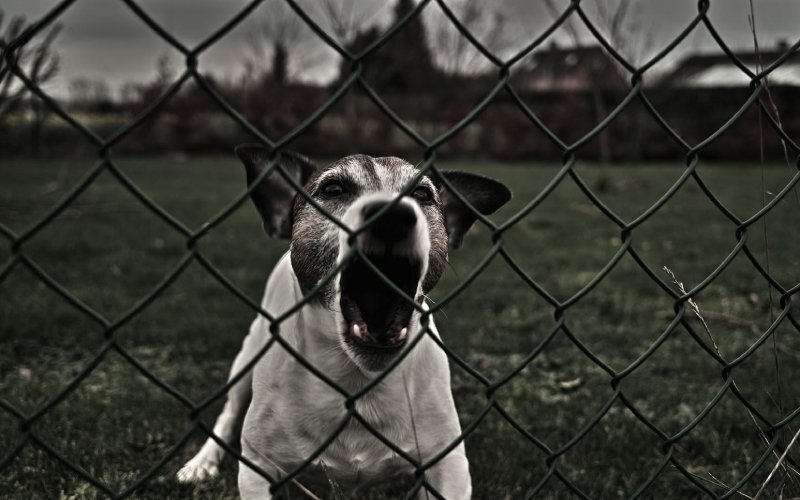If your dog has been growling, snapping, or biting regularly, it might have developed aggression— it doesn’t matter if your dog is a Rottweiler, Labrador, or a Poodle.
Dogs of any breed can get aggressive if the conditions are such, and that’s why dog aggression is the most common behavioral issue in domestic dogs. Interestingly, it is also one of the leading reasons why dog parents seek professional help from trainers and veterinarians.
Today, we will discuss everything you need to know about dog aggression. By the end of this blog, you will be able to determine if your dog has developed this issue and what to do next if it has.
Dog Aggression: Definition and Types
Aggression in dogs is mainly defined as behaviors like barking, growling, biting, and other actions that may be harmful to their surroundings. Prominent symptoms include growling, snapping, going rigid while their tail wags quickly, licking lips or yawning, raised fur, averting gaze, cowering and tail tucking, and showing on the whites of their eyes.
Dogs can get aggressive due to various reasons. It is crucial to understand why a dog has developed aggression so that treatments can be effective. These reasons are types of aggression behaviors in dogs. The most common ones include:
Territorial Aggression
Dogs are territorial and may get aggressive if a human or another animal enters their territory.
Possessive Aggression
Similar to territorial aggression, a dog may show aggressive signs if it feels threatened that its possessions, like food or toys, might be taken away.
Maternal or Protective Aggression
Female dogs may show aggression if they feel that the safety of their puppies is compromised by external sources.
Pain-related or Irritable Aggression
Female dogs may show aggression if they feel that the safety of their puppies is compromised by external sources.
Predatory Aggression
Sometimes a canine’s primary instincts can kick in. If it considers something or someone prey, it might bite.
Frustration or Redirected Aggression
Dogs can feel frustrated by many factors, such as changes in their environment, improper handling, and other external factors that impact them directly. In such cases, they tend to release that frustration through aggression.
Social Conflict-Related Aggression
Getting aggressive toward familiar people or animals is a result of social conflict-related aggression. This type of aggression is motivated by inner turmoil and shown in social interactions.
Sexual Aggression
If a dog has experienced difficulties in mating, they might fight over the attention of male or female dogs— that is known as sexual aggression.
Disease-Related Aggression
Similar to pain-related aggression, dogs tend to get aggressive when suffering from diseases. That’s because illnesses disrupt their routine and make them irritated and frustrated.
Fear or Anxiety-Related Aggression
The most common type of aggression in dogs occurs due to fear or anxiety caused by unfamiliar environments or threatening situations.
Risk Factors Associated with Aggression in Dogs
If you choose to continue living with your aggressive dog and treat it, then you need to understand the risk factors that contribute to aggression and lead to further issues.
According to a study, the common risk factors that contribute to dog aggression are:
- Sex and breed
- Reason for acquiring the dog
- Owner’s experience in handling the dog
- Housing and accommodation
- Number of dogs in the household
- Number of household members
Other risk factors include disease or pain, inappropriate training, punishment methods, poor welfare, neglect, and a harmful environment.
Also, when choosing to live with an aggressive dog, you may want to consider the following:
- Size — Large dogs inflict greater damage
- Age — Older dogs are more difficult to treat than younger ones
- Bite history — Dogs with a bite history pose a greater risk
- Aggression severity — Dogs who bite when aggressive are significantly less safe to live with
- Aggression predictability — Dogs with inconsistent and unpredictable aggression are at the highest risk of euthanization
- Targets & Triggers— Dogs who cannot be separated from targets and triggers of their aggression are more difficult to manage and treat
- Dog Motivation — Dogs who are difficult to motivate during retraining may not be treated successfully
As a dog parent, you must take precautions, such as removing the triggers, training the dog, helping it get used to new environments, and ensuring its well-being.
Aggression can be treated, but it is important to first understand the triggers. You can do that by talking to a vet. Next, seek professional help for your four-legged friend— this may include enrolling your dog in a training program, getting medications, or trying other behavior adjustment methods.
Conclusion
Remember, aggression in dogs is dangerous and can result in severe damage to the dog, you, and anyone and everything around it. However, this does not mean your furry pal has become evil and hateful of everything.
For dogs, aggression is just a means of communication that they may use to indicate uneasiness, discomfort, pain, or feeling threatened. As a dog parent, if you notice any sign of aggression, it is your responsibility to immediately take action. Start by understanding the reason for aggression, then look for treatment accordingly.
If you suspect your dog has developed aggressive behavior, talk to a vet and seek professional help from Off Leash K9 Training as soon as possible.
423-430-6559
[email protected]
olk9chatt.com



